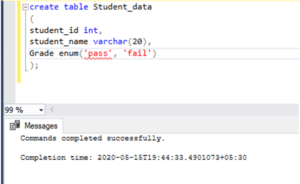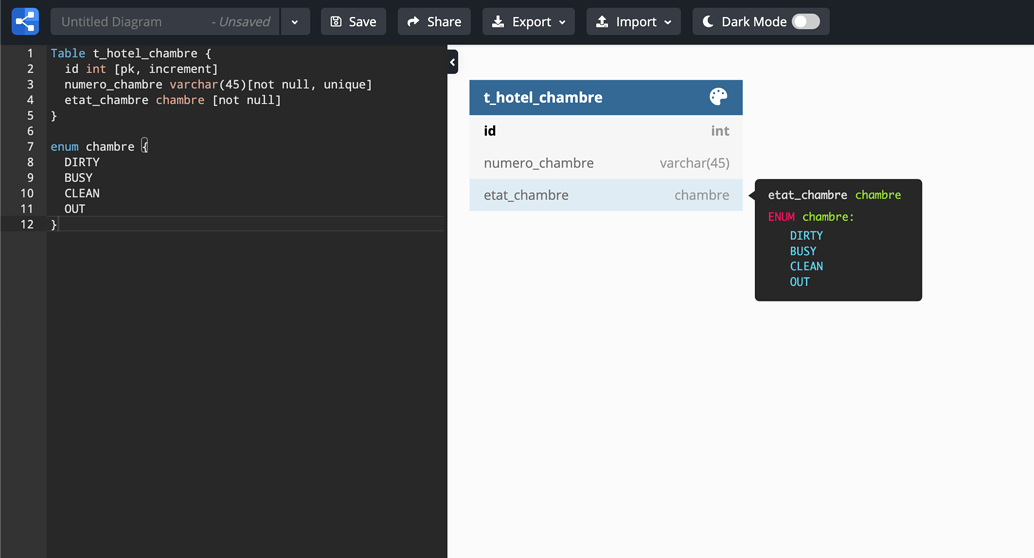
For example, the following statement inserts a new row into the tickets table. To insert data into an ENUM column, you use the enumeration values in the predefined list. In this case, Low, Medium, and High are map to 1, 2 and 3 respectively. Behind the scenes, MySQL maps each enumeration member to a numeric index. The priority column will accept only three values Low, Medium and High. Priority ENUM( 'Low', 'Medium', 'High') NOT NULL To assign the priority column the ENUM type, you use the following CREATE TABLE statement: CREATE TABLE tickets ( Suppose, we have to store ticket information with the priority: low, medium, and high. However, it is a good practice to keep the number of enumeration values under 20. In this syntax, you can have more than three enumeration values. To define an ENUM column, you use the following syntax: CREATE TABLE table_name (Ĭol ENUM ( 'value1', 'value2', 'value3'),Ĭode language: SQL (Structured Query Language) ( sql ) MySQL ENUM uses numeric indexes (1, 2, 3, …) to represents string values.

The ENUM data type provides the following advantages: In MySQL, an ENUM is a string object whose value is chosen from a list of permitted values defined at the time of column creation.
#Mysql enum how to#
If not the dialect-specific datatype object.Ĭlass ( sqlalchemy.types._LookupExpressionAdapter, ) method : in this tutorial, you will learn how to use MySQL ENUM data type for defining columns that store enumeration values. Timezone support, use at least the TIMESTAMP datatype, For fractional seconds, use theĭialect-specific datatype, such as TIME. SQLite, date and time types are stored as strings which are thenĬonverted back to datetime objects when rows are returned.įor the time representation within the datetime type, someīackends include additional options, such as timezone support andįractional seconds support. Module, with the noted exception of SQLite. Most DBAPIs have built in support for the datetime DateTime ( timezone = False ) ¶ĭate and time types return objects from the Python datetime This can be useful for calling setinputsizes(), for example. Return the corresponding type object from the underlying DB-API, if “literal_binds” flag, typically used in DDL generation as wellĪs in certain scenarios where backends don’t accept bound parameters.Ĭlass ( sqlalchemy.types._LookupExpressionAdapter, ) method. This function is used when the compiler makes use of the To be rendered directly without using binds. Return a conversion function for processing literal values that are Parameters :ĭialect ¶ – Dialect instance in use. If processing is not necessary, the method should return None. Returns a callable which will receive a bind parameter valueĪs the sole positional argument and will return a value to Return a conversion function for processing bind values. Name ¶ – if a CHECK constraint is generated, specify On the table that ensures 1 or 0 as a value. Is generated as an int/smallint, also create a CHECK constraint _init_ ( create_constraint = True, name = None, _create_events = True ) ¶Ĭreate_constraint ¶ – defaults to True. Typically generates a BIGINT in DDL, and otherwise acts likeĬlass (, , ) method. The base for all string and character types. Mark a type as possibly requiring schema-level DDL for usage. Holds Python objects, which are serialized using pickle. NUMERIC, FLOAT, DECIMAL, and other variants. Refers to the return type of the MATCH operator.īase for non-integer numeric types, such as

Type representing floating point types, such as FLOAT or REAL. SQL Standard and Multiple Vendor Types and the other sections of this chapter. Type is emitted in CREATE TABLE, such as VARCHAR see SQLAlchemy will choose the bestĭatabase column type available on the target database when issuing aĬREATE TABLE statement.

Generic types specify a column that can read, write and store a To Integer() with no construction arguments in this case. Typically accept a type class or instance Integer is equivalent Information when issuing a CREATE TABLE statement and will use itĪgain when reading back rows SELECTed from the database.įunctions that accept a type (such as Column()) will

SQLAlchemy will use the Integer and String(32) type Column ( 'id', Integer, primary_key = True ).


 0 kommentar(er)
0 kommentar(er)
